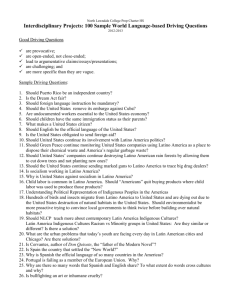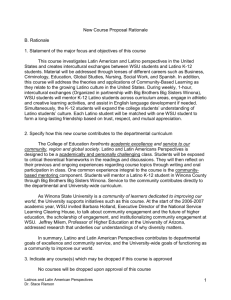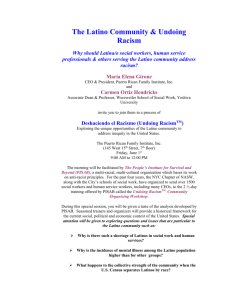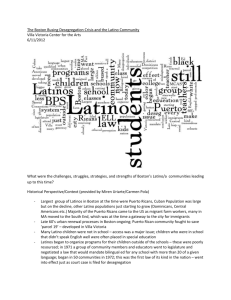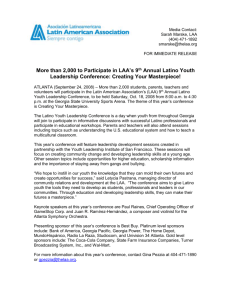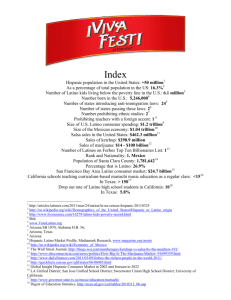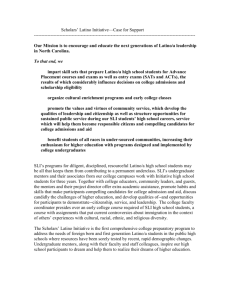advertisement
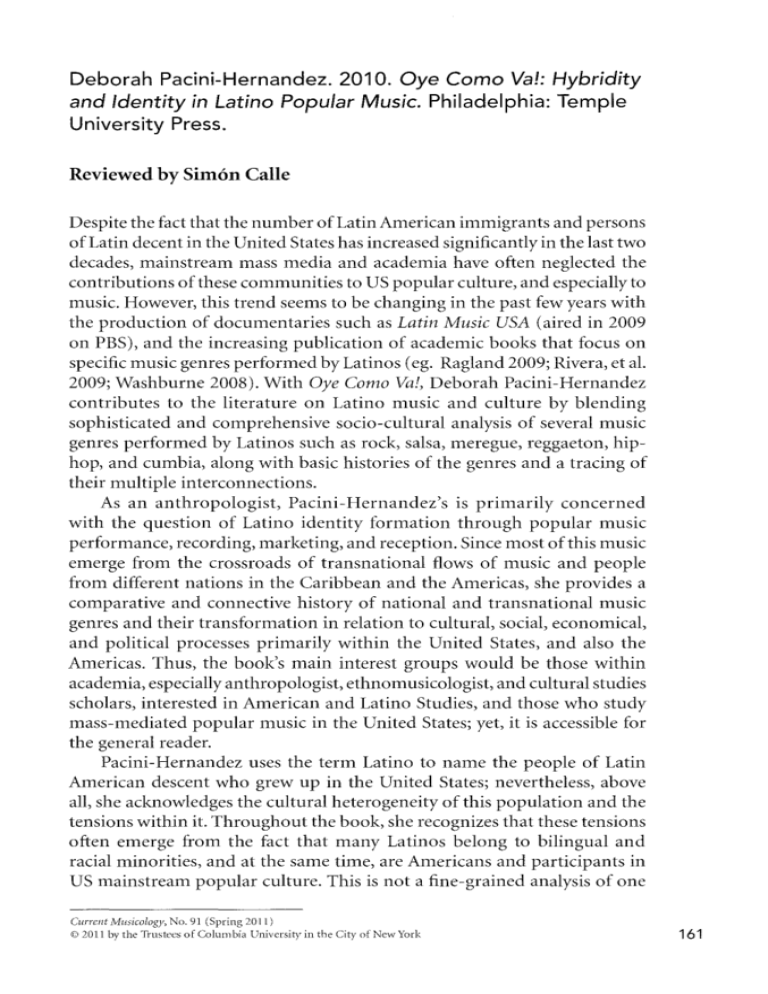
Deborah Pacini-Hernandez. 2010. Dye Como Va!: Hybridity and Identity in Latino Popular Music. Philadelphia: Temple University Press. Reviewed by Simon Calle Despite the fact that the number of Latin American immigrants and persons of Latin decent in the United States has increased significantly in the last two decades, mainstream mass media and academia have often neglected the contributions of these communities to US popular culture, and especially to music. However, this trend seems to be changing in the past few years with the production of documentaries such as Latin Music USA (aired in 2009 on PBS), and the increasing publication of academic books that focus on specific music genres performed by Latinos (eg. Ragland 2009; Rivera, et al. 2009; Washburne 2008). With Oye Como Va!, Deborah Pacini-Hernandez contributes to the literature on Latino music and culture by blending sophisticated and comprehensive socio-cultural analysis of several music genres performed by Latinos such as rock, salsa, meregue, reggaeton, hiphop, and cumbia, along with basic histories of the genres and a tracing of their multiple interconnections. As an anthropologist, Pacini-Hernandez's is primarily concerned with the question of Latino identity formation through popular music performance, recording, marketing, and reception. Since most of this music emerge from the crossroads of transnational flows of music and people from different nations in the Caribbean and the Americas, she provides a comparative and connective history of national and transnational music genres and their transformation in relation to cultural, social, economical, and political processes primarily within the United States, and also the Americas. Thus, the book's main interest groups would be those within academia, especially anthropologist, ethnomusicologist, and cultural studies scholars, interested in American and Latino Studies, and those who study mass-mediated popular music in the United States; yet, it is accessible for the general reader. Pacini-Hernandez uses the term Latino to name the people of Latin American descent who grew up in the United States; nevertheless, above all, she acknowledges the cultural heterogeneity of this population and the tensions within it. Throughout the book, she recognizes that these tensions often emerge from the fact that many Latinos belong to bilingual and racial minorities, and at the same time, are Americans and participants in US mainstream popular culture. This is not a fine-grained analysis of one Currerlt Musicology, No. 91 (Spring 2011) © 2011 by the Trustees of Colum bia University in the City of New York 161 Current Musicology musical genre in its immigrant communities, but rather a macroscopic view of Latino music, acknowledging its diversity while unveiling another set of tensions that emerge from the different origins, population size, and visibility of the different Latino communities in the United States. Pacini -Hernandez does not conflate the distinct nationalities and cultural heritage of Latin American immigrants and their descendants, but rather acknowledges their differences, similarities, and the tensions that complicate the general idea of a unified "Latino cultural identity." Nonetheless, the book focuses primarily on the music and histories of Latinos whose music has had a significant impact in North American mainstream popular culture and elsewhere. Therefore, she focuses primarily on those Latinos of Puerto Rican and Mexican origin, the two groups with the largest presence in the United States; but PaciniHernandez also includes chapters on the music and experiences of recent migration waves of Dominicans and Colombians, and how their music has transformed and responded to previous waves of immigration. However, in a few chapters she touches on the role of Cubans and their music, both of which have had a great impact in American popular culture. In the first chapter, which serves as a theoretical introduction, PaciniHernandez approaches the question of Latino identity formation through popular music. She states that Latino music, a result of the crossing and in-betweeness of musical, geographic, racial, and ethnic boundaries, should be analyzed in terms of the multiple transnational flows of people and culture, the engagement of Latinos with US mainstream culture and music industry, and Latin American hybridity. Through this approximation, she acknowledges the diversity within Latino music, always conflated by the commercial music industry under the rubric "Latin music. "This term erases the differences between the different musics produced and performed in Latin America and by Latinos in the United States; yet, she recognizes the interconnection between musical aesthetics often associated with particular national groups and migrant communities. Second, she identifies processes of hybridity, defined as "the mixture of two or more dissimilar elements," which "produces objects and people that are in between and out of place" (Pacini-Hernandez 201O:vii), within the United States. Despite centrally positioning hybridity as one of the key concepts throughout the book, PaciniHernandez often uses the term simply as a trope for mixture. The definition ofhybridity is highly contested within postcolonial studies, Latin American cultural studies, and in anthropological literature (see Garcia -Canclini 2005), a debate she evades; however, in acknowledging cultural and racial mixture in her study of popular music in the United States, Pacini-Hernandez makes an important contribution to the field of Latino popular music studies. 162 Simon Calle Recognizing processes of racial and cultural mixture is crucial to the understanding of racial and cultural formations and imaginaries in Latin America. Scholars and commentators of music from Latin America and the Spanish-speaking Caribbean have pointed to these processes to understand musical practices and their transformations (eg. Austerlitz 1997; Moore 1997; Ortiz 1995; Wade 2000). At the same time, they have used terms such as creolization, transculturation, hybridity, and mestizaje to name such processes. Pacini-Hernandez states that this has not been the case for the study of the United States, where racial and cultural identity has historically been imagined within the clear, divisive binary of black and white. This imagined racial division has marked the way in which people understand popular music in the United States, as well as the scholarship and popular literature on this topic. However, in order to understand and capture the nuances of Latino identity and musical productions, it is important to incorporate into the theoretical framework concepts like hybridity and mestizaje (racial mixture), which challenge the American racial imaginary. For this reason, Hernandez focuses the remainder of Oye Como Va! on distinct, yet shared cultural processes that are characterized by the blending of musical genres, transnational flows, and the tensions that emerge from migration and negotiations of national and cultural identity. The second and seventh chapters focus on the history of the Latino music industry in the United States. The former deals with its emergence in the early twentieth century until 1980s. Pacini-Hernandez looks at the music industry in both in the West and East Coast, but focuses in extent with the second one, narrating the histories of landmark Latino music labels Tico, Seeco, Alegre, and Fania. In chapter 7, she deals with the transformations of the Latino music industry since the 1990s when not only did immigration from Latin America to the United States increased during this period, but also circulation of music from around the world grew in the US market. The chapter divided into three parts that looks at the ways in which Latino music has participated in the "world beat" or "world music" market, the impact of increasing immigration to the United States, and the role of major record labels and the concentration of the Latino music industry in Miami. Chapter 3 is a comparative study from a historical perspective of the way in which Mexican immigrants in Los Angeles and Puerto Ricans in New York adopted and transformed rock en' roll in relation to their own national identities and ethnic consciousness. Through this, Pacini-Hernandez explores the emergence and development of Chicano rock, latin boogaloo, and salsa. Chapter 4 deals with the involvement of Latinos of Cuban, Mexican, and Puerto Rican origins with rap, disco, and freestyle. The chapter first focuses on the different ways in which Latinos in New York and Los Angeles 163 Current Musicology were involved with these genres, which are often considered to be "black music" during the 1970s and 1980s. In a second section, Pacini-Hernandez explores the emergence of reggaeton in Puerto Rico from the international circulation of different Caribbean musical genres between the 1980s and 1990s, and its subsequent success in the United States in the 2000s. Chapter 5 looks at recent Dominican migration and the resulting transformations of merengue and bachata carried out by second-generation Dominicans in New York, which consequently transformed the performance and reception of those same musical genres in the Dominican Republic. In the chapter, Pacini-Hernandez goes in depth in the history of these musical genres and its significance in terms of race and class relations and social the Dominican Republic. She argues that the new styles of merengue, and bachata produced island's traditional hierarchies. Chapter 6 offers one of the first approximations in English language scholarship of Colombian music genres such as cumbia and vallenato as performed and received in the United States. In a second section, PaciniHernandez considers cumbia as cosmopolitan musical form, which lost its original connection to the Colombian Caribbean, as Peruvian, Argentinean, and Mexican musicians have adopted the genre as their own and transformed it, later bringing their own versions of cumbia to the United States. In Oye Como Va! Pacini-Hernandez offers the reader a solid introduction to some of the genres of Latino music in the United States, their relationship to one another, as well as to music from Latin America and the Caribbean. At the same time, the book focuses on music from the perspective of the effects of the flows of people between nation-states, and culture. One important contribution of the book is its recognition of hybridity within the United States, and the relating of hybridity to music as a processes of identity formation. This book extends beyond presenting a historical survey of Latin American and Latino music in the United States to make an overarching argument about Latino music culture-a necessary part of critical discussions on race and ethnicity in the United States. References Austerlitz, Paul 1997. Merengue: Dominican music and Dominican identity. Philadelphia: Temple University Press. Garcia-Canclini, Nestor. 2005. Hybrid cultures in globalized times. In Hybrid cultures: strategies for entering modernity. Pp. xxiii-xlvi. Minneapolis: University of Minnesota Press. Moore, Robin. 1997. Nationalizing blackness: Afrocubanismo and artistic Revolution in Havana, 1920-1940. Pittsburgh: Universi ty of Pittsburgh Press. Ortiz, Fernando.l99s. Cuban counterpoint: Tobacco and sugar. Durham N.C.: Duke University Press. Ragland, Cathy. 2009. Musica norteiia: Mexican migrants creating a nation between nations. Philadelphia: Temple University Press. 164 Simon Calle Rivera, Raquel Z., Wayne Marshall, and Deborah Pacini-Hernandez. 2009. Reggaeton. Durham NC: Duke University Press. Wade, Peter. 2000. Music, race, & nation: "Musica tropical" in Colombia. Chicago: University of Chicago Press. Washburne, Christopher. 2008. Sounding salsa: performing Latin music in New York City. Philadelphia: Temple University Press 165



